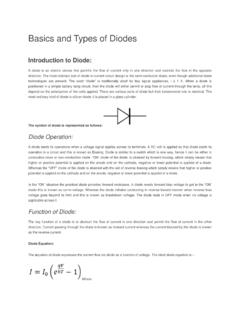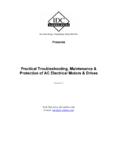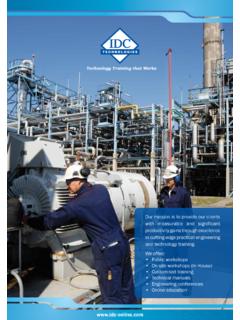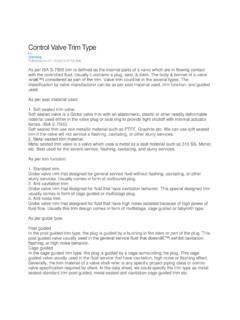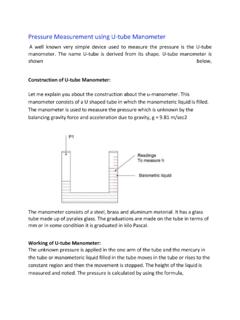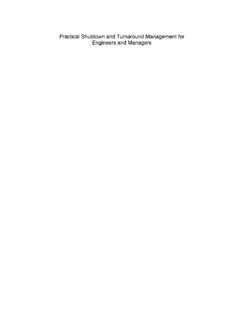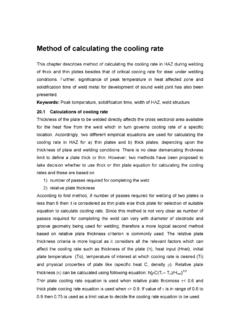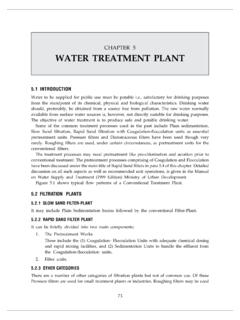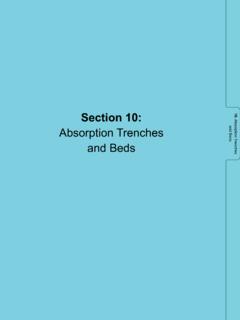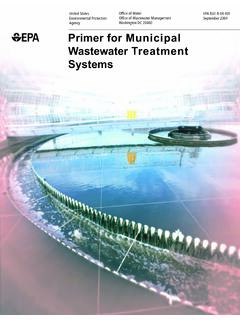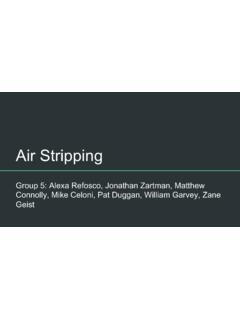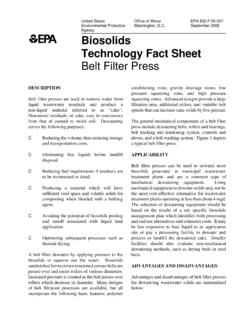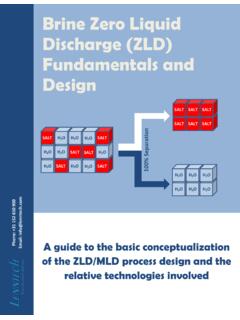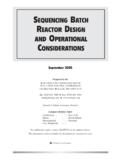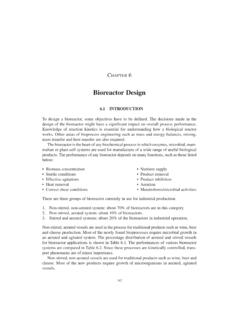Transcription of ENVIRONMENTAL POLLUTION - CONTROL MEASURES
1 ENVIRONMENTAL POLLUTION - CONTROL MEASURES C. Fundamentals of prevention and CONTROL of air POLLUTION : As mentioned above, air pollutants can be gaseous or particulate matters. Different techniques for controlling these pollutants are discussed below: a. Methods of controlling gaseous pollutants 1. Combustion This technique is used when the pollutants are in the form of organic gases or vapors. During flame combustion or catalytic process, these organic pollutants are converted into water vapor and relatively less harmful products, such as CO2. 2. Absorption In this technique, the gaseous effluents are passed through scrubbers or absorbers.
2 These contain a suitable liquid absorbent, which removes or modifies one or more of the pollutants present in the gaseous effluents. 3. Adsorption The gaseous effluents are passed through porous solid adsorbents kept in suitable containers. The organic and inorganic constituents of the effluent gases are trapped at the interface of the solid adsorbent by physical adsorbent. b. Methods to CONTROL particulate emissions 1. Mechanical devices generally work on the basis of the following: dustbagfilter (i) Gravity: In this process, the particles settle down by gravitational force. (ii) Sudden change in direction of the gas flow. This causes the particles to separate out due to greater momentum.
3 2. Fabric Filters: The gases containing dust are passed through a porous medium. These porous media may be woven or filled fabrics. The particles present in the gas are trapped and collected in the filters. The gases freed from the particles are discharged. 3. Wet Scrubbers: Wet scrubbers are used in chemical, mining and metallurgical industries to trap SO2, NH3, metal fumes, etc. 4. Electrostatic Precipitators: When a gas or an air stream containing aerosols in the form of dust, fumes or mist, is passed between two electrodes, then, the aerosol particles get precipitated on the electrode. dustelectrostaticprecipitator c. Other practices in controlling air POLLUTION - Apart from the above, following practices also help in controlling air POLLUTION .
4 (i) Use of better designed equipment and smokeless fuels, hearths in industries and at home. (ii) Automobiles should be properly maintained and adhere to recent emission- CONTROL standards. (iii) More trees should be planted along road side and houses. (iv) Renewable energy sources, such as wind, solar energy, ocean currents, should fulfill energy needs. (v) Tall chimneys should be installed for vertical dispersion of pollutants. d. General air POLLUTION CONTROL devices / equipments for industries The commonly used equipments / process for CONTROL of dust in various industries are (a) Mechanical dust collectors in the form of dust cyclones; (b) Electrostatic precipitators both dry and wet system; (c) particulate scrubbers; (d) Water sprayer at dust generation points; (e) proper ventilation system and (f) various monitoring devices to know the concentration of dust in general body of air.
5 The common equipments / process used for CONTROL of toxic / flue gases are the (a) process of desulphurisation; (b) process of denitrification; (c) Gas conditioning etc. and (d) various monitoring devices to know the efficacy of the systems used. e. Steps, in general, to be taken for reduction of air POLLUTION - To change our behavior in order to reduce AIR POLLUTION at home as well as on the road, few following small steps taken by us would lead to clean our Environment. At Home: 1. Avoid using chemical pesticides or fertilizers in your yard and garden. Many fertilizers are a source of nitrous oxide, a greenhouse gas that contributes to global warming.
6 Try organic products instead. 2. Compost your yard waste instead of burning it. Outdoor burning is not advisable, as it pollutes air. Breathing this smoke is bad for you, your family and your neighbors. Plus, you can use the compost in your garden. 3. If you use a wood stove or fireplace to heat your home, it would be better to consider switching to another form of heat which does not generate smoke. It is always better to use sweater or warm clothing than using fireplace. 4. Be energy efficient. Most traditional sources of energy burn fossil fuels, causing air POLLUTION . Keep your home well-maintained with weather-stripping, storm windows, and insulation.
7 Lowering your thermostat can also help and for every two degrees Fahrenheit you lower it, you save about two percent on your heating bill. 5. Plant trees and encourage other to plant trees as well. Trees absorb and store carbon dioxide from the atmosphere, and filter out air POLLUTION . During warmer days, trees provide cool air, unnecessary use of energy on air conditioning is avoided, hence the air POLLUTION . 6. Try to stop smoking; at home, at office or at outside. Tobacco smoking not only deteriorates self s health, it affects others health too. On the Road: 7. Keep your vehicle well maintained. A poorly maintained engine both creates more air POLLUTION and uses more fuel.
8 Replace oil and air filters regularly, and keep your tires properly inflated. 8. Drive less. Walking, bicycling, riding the bus, or working from home can save you money as well as reducing air POLLUTION . 9. Don t idle your vehicle. If you stop for more than 30 seconds, except in traffic, turn off your engine. 10. Don t buy more car than you need. Four-wheel drive, all-wheel drive, engine size, vehicle weight, and tire size all affect the amount of fuel your vehicle uses. The more fuel it uses the more air POLLUTION it causes. D. Water POLLUTION prevention and CONTROL : Water is a key resource for our quality of life. It also provides natural habitats and eco-systems for plant and animal species.
9 Access to clean water for drinking and sanitary purposes is a precondition for human health and well-being. Clean unpolluted water is essential for our ecosystems. plants and animals in lakes, rivers and seas react to changes in their environment caused by changes in chemical water quality and physical disturbance of their habitat. Water POLLUTION is a human-induced change in the chemical, physical, biological, and radiological quality of water that is injurious to its existing, intended, or potential uses such as boating, waterskiing, swimming, the consumption of fish, and the health of aquatic organisms and ecosystems. Thus, the discharge of toxic chemicals from a pipe or the release of livestock waste into a nearby water body is considered POLLUTION .
10 The contamination of ground water, rivers, lakes, wetlands, estuaries, and oceans can threaten the health of humans and aquatic life. Contaminants have a significant impact on aquatic ecosystems. for example, enrichment of water bodies with nutrients (principally nitrogen and phosphorus) can result in the growth of algae and other aquatic plants that shade or clog streams. Direct exposures to toxic chemicals such as pesticides, is also a health concern for individual aquatic plants and animals. Without healthy water for drinking, cooking, fishing, and farming, the human race would perish. Clean water is also necessary for recreational interests such as swimming, boating, and water skiing.
